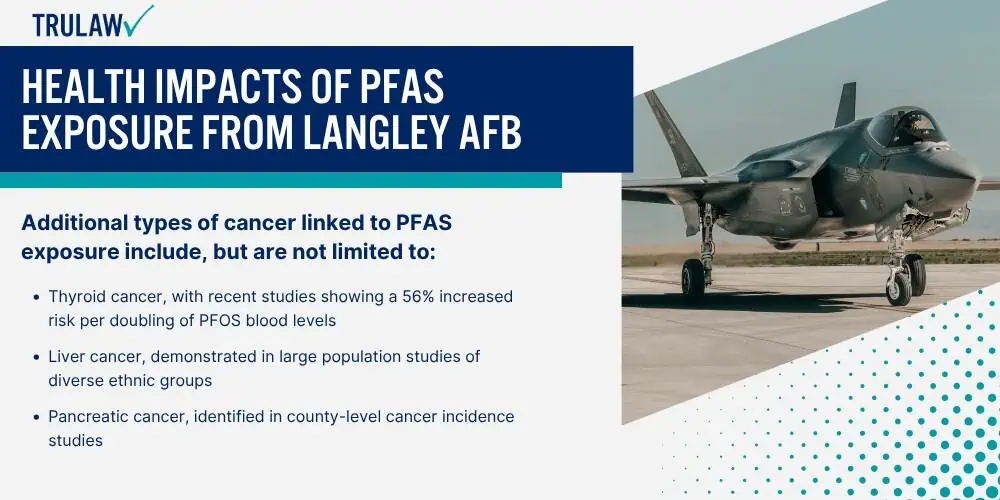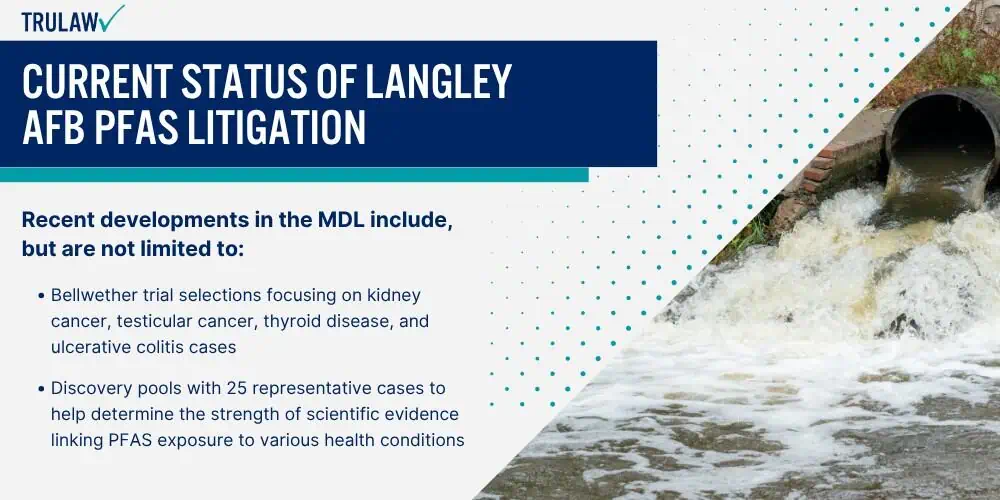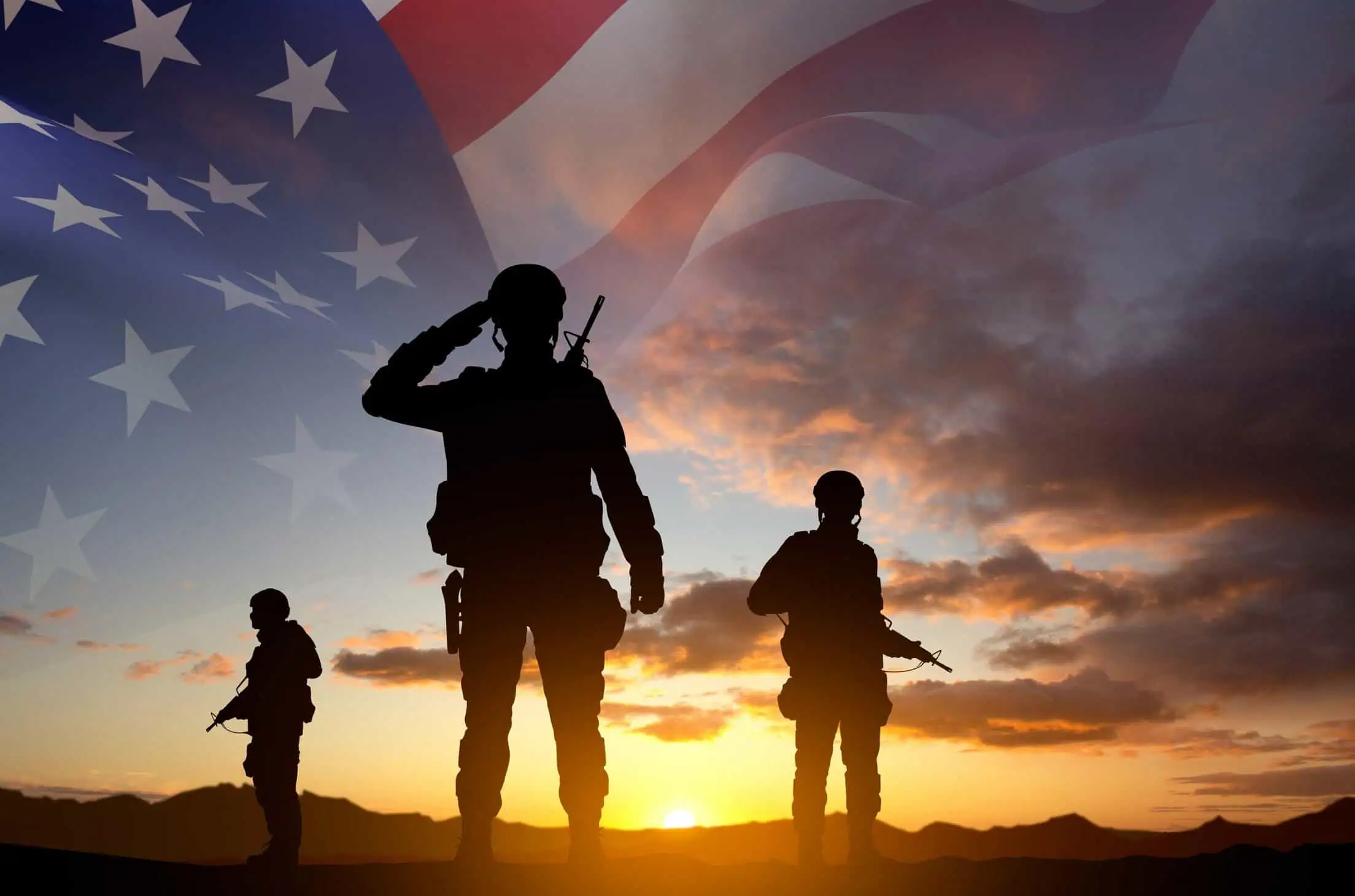PFAS exposure from Langley Air Force Base contamination has been linked to numerous serious health conditions that form the foundation of current litigation efforts.
These health issues affect multiple organ systems and can develop years or decades after initial exposure.

Our analysis of scientific research shows that individuals exposed to PFAS-contaminated water face significant health risks including cancer, reproductive problems, and immune system disorders.
Prolonged PFAS exposure creates additional concerns as these chemicals accumulate in the human body over time.
The extremely high contamination levels at Langley (exceeding 2 million parts per trillion) represent exposure concentrations far above those studied in most health research, potentially leading to more severe health outcomes for affected individuals.
These serious health issues may require lifelong medical monitoring and treatment.
Cancer and Serious Health Conditions
Research consistently demonstrates strong connections between PFAS exposure and several types of cancer that qualify for compensation in current lawsuits.
These adverse health effects can devastate families and require extensive medical treatment.
Kidney cancer shows the most robust scientific evidence, with studies indicating that individuals with elevated PFAS blood levels face more than double the risk of developing renal cell carcinoma compared to those with lower exposure levels.
Testicular cancer represents another well-established link to PFAS exposure, particularly among military personnel.
Similar patterns have been documented at other contaminated installations including Ellsworth Air Force Base, Altus Air Force Base, and Holloman Air Force Base.
Studies of Air Force servicemen found that elevated blood levels of PFOS substantially increased testicular cancer risk, with the strongest associations observed among firefighters and personnel stationed at bases with high water contamination levels.
Additional types of cancer linked to PFAS exposure include, but are not limited to:
- Thyroid cancer, with recent studies showing a 56% increased risk per doubling of PFOS blood levels
- Liver cancer, demonstrated in large population studies of diverse ethnic groups
- Pancreatic cancer, identified in county-level cancer incidence studies
Beyond cancer, PFAS exposure causes thyroid disease, ulcerative colitis, and elevated cholesterol levels.
These serious health problems often develop years before cancer diagnoses and may serve as early indicators of PFAS-related health impacts in affected populations.
Reproductive and Developmental Effects
PFAS contamination poses particular risks to pregnant women and developing children in families stationed at or living near Langley AFB.
The Environmental Working Group has documented similar reproductive health impacts at military installations nationwide.
Our research shows that PFAS exposure during pregnancy increases risks of conditions including, but not limited to:
- Preeclampsia
- Gestational diabetes
- Pregnancy-induced hypertension
These conditions can threaten both maternal and fetal health, creating lasting human health impacts for both mother and child.
Infants born to mothers with PFAS exposure face increased risks of low birth weight, developmental delays, and altered immune system function. Immune system suppression represents one of the most concerning long-term effects of PFAS exposure in children.
Children exposed to PFAS may experience accelerated puberty, behavioral changes, and reduced vaccine effectiveness – potentially compromising their long-term health outcomes.
Military families face unique reproductive health challenges due to potential multiple base assignments and cumulative PFAS exposure over extended periods. Families stationed at installations like Wurtsmith Air Force Base, Naval Air Station Jacksonville, and Vandenberg Air Force Base may experience similar health impacts from prolonged exposure to contaminated water.
These families may experience fertility problems, hormonal disruptions, and intergenerational health effects that impact multiple family members across different life stages. Food packaging contamination can create additional exposure pathways for military families living on base.
Exposure Pathways and Duration
Drinking contaminated water represents the primary exposure route for individuals near Langley AFB, with daily consumption leading to bioaccumulation of PFAS in blood and organs.
We calculate that residents consuming water with PFAS levels found at Langley could accumulate dangerous body burdens within months of initial exposure.
Secondary exposure pathways include, but are not limited to:
- Dermal absorption during showering, bathing, and swimming in contaminated water sources
- Direct occupational contact with firefighting foam during training exercises or emergency responses for base personnel and contractors
PFAS bioaccumulate over time, meaning that even relatively brief exposure periods can result in elevated blood levels that persist for years after exposure ends. Military personnel at installations like Horsham Air Guard Station, Grand Prairie Armed Forces, and Air National Guard Base locations face similar occupational exposure risks.










